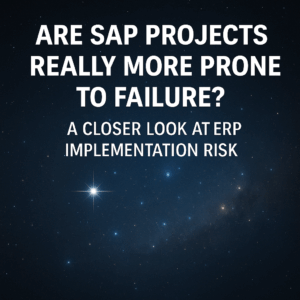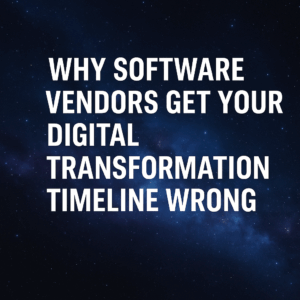As humans, we’re hardwired to take action, however, oftentimes we take actions that undermine our digital transformation efforts. It’s these actions that should be avoided if you want to have a successful transformation. In this article, we are going to go over some of the top actions that you should NOT do in a digital transformation.
One of the things that plagues digital transformations isn’t just the software that’s selected or the system integrator that is involved in your implementation, it’s also the decisions that you as an organization oftentimes make that can actually undermine a digital transformation.
To start, it helps to understand a concept that’s been well researched, which is called action bias. Action bias essentially states that humans have a tendency to want to take action even if it results in something less beneficial than if you just would have done nothing. A good example would be if you’ve ever been in the supermarket and you try to find the line that’s moving the fastest and you move out of your current line to go to a seemingly faster queue, oftentimes you find that you didn’t get to the front any faster. In some cases, you were actually set back.
Another example that’s been researched as part of this action bias study is in the world of soccer. In soccer, players typically evenly distribute where they shoot their goals, about a third are shot straight down the middle, a third are shot to the left and about a third are shot to the right. Research shows that goalies will 94% of the time jump to one side or the other, which suggests that they’re taking action that actually results in lower statistical success than if they would have just stayed in the middle of the goal.
These are just two examples of action bias and the way that we’re hardwired to take action. What I want to do today is talk about five things that we see digital transformation teams do too often that undermines the likelihood of digital transformation success.

Table of Contents
ToggleTake Action Toward a Biased Technology
The first thing that organizations too often do is that they take action towards a biased technology evaluation. In other words, they know they need to replace their current technology, they know they need to go through a digital transformation and they start contacting software vendors and sales reps from system integrators and implementers as well. This plan sounds reasonable enough but what ends up happening is in the quest to take action and just to go directly to the source of the software provider, they end up with a biased evaluation process and they don’t get an objective view of what the potential options are. They ignore what the strengths or weaknesses are and what the risks are for whatever technology they might choose. Rather than focusing on a biased evaluation, where you contact biased parties to help you through the evaluation, we see organizations be more successful when they reach out to an independent and technology agnostic advisor that can help them make an informed decision that is unbiased and objective and more aligned with their needs.
This is counterintuitive, it’s an option that a lot of organizations oftentimes don’t even think about because they don’t know it exists. Organizations like ours at Third Stage Consulting are a good example of an independent technology advisor that can help you make the right decision in a way that’s unbiased and ensures that you find the right solution for your digital transformation.
Implementing Tech Right Away
Once organizations have selected the software that they want to deploy, the organization tends to jump right into the implementation phase and this in my opinion, of the five that I’m going to talk about, is the one that’s the most destructive and the most damaging. This is because when you’ve picked a software technology, the tendency is to want to just jump in and start building out the software and the pieces the vendor wants you to buy.
It seems understandable that we as humans would want to rush in and start moving and taking action but what we find is that organizations jump in prematurely and they start designing and building before they have the foundation built. It’s a lot like building a house, you may want a house with running water but that doesn’t mean that the first thing you do is contact the plumber. The first thing you do is you generally contact an architect and then maybe a general contractor who then will eventually bring in the plumber when the time is right. We as humans are wired to think about reaching out to the plumber first because that’s what we want, we want the running water in the house. Similar to digital transformation, we want to see, touch and feel the software because we feel like that’s the foundation of our digital transformation but technology is just an enabler. The real foundation, the real things we should be focused on, are not building the software right away but defining our end-to-end processes, defining how our business model might change as a result of the transformation, defining roles and responsibilities in the organizational design of the company before we start the implementation. Additionally, getting program management, project governance and controls in place, all those things are critical prerequisite tasks that you should do before you start bringing in the technology provider to start designing and building software. This is another example of an action that you want to make sure you don’t take. You don’t want to jump right in and just start designing and building, you want to take a step back to be able to build that foundation first. This allows you to speed things up and be more effective later on.
Defining Business Processes With Technology
Another action bias that humans have is that they don’t want to take the time to define their end-to-end processes before designing or building the software. Too often they think that we’re just going to defer to the software, we’re going to use the software as the definition of how our software will work and that may be true at the very granular, transactional level but today’s software in the enterprise technology space is so flexible and can do so many different things, that you have to have a clear vision of what you want your processes to be before you start deploying technology. Add to the fact that the world and the economy has become more competitive than ever, so it’s important for you to define what your competitive advantages are, what your priorities are for the transformation and really develop that blueprint that will provide the foundation for how the software vendor will start to deploy technology. It’s imperative to resist the urge to want to just build the technology and then figure out what your processes are going to look like after. Instead, flip that process and focus on business processes first, then as you start to design and build the software, you will further define and refine how those processes will look at a more granular level. You need to have that foundational, end-to-end business process vision in place before you start your project if you want to be successful.

Implementing Tech Without a Change Strategy
Change management or the human side of change, is one of the hardest things for us as humans to see and understand. Human dynamics and organizational changes are something that you can’t easily see, touch and feel, as you can with software, so it’s understandable that we as humans will brush that aside and focus on the things we can more readily see, touch and feel. The bias here is that we want to start designing and building technology and then later we’ll figure out the change management piece. There’s a thinking that we’ll get to the training, we’ll get to the communications, change management, organizational readiness, change impact analysis, there’s a whole host of things that are really important and critical during a digital transformation. The problem is we can’t see it, we can’t touch it and we can’t feel it and likewise, in some cases we can’t quantify it so we end up reverting to the things that we can see or touch.
It’s important to recognize this blind spot that we as humans have and recognize that change management is absolutely critical to the success of your project. It’s also likely to be the thing that is on the critical path for your transformation so you need to start it sooner than later and so the more you can do to make change management tangible measurable and something you can see, touch and feel the more likely it is that you’ll be able to get the critical mass and support for those change initiatives.
Hiring Your Implementer To Be Your PMO
The fifth big action bias that we see in digital transformations is that organizations say they don’t have an internal program manager or program management office and so they simply outsource that function to their system integrator or their technical implementer. This may sound reasonable and understandable why one might do that but it’s highly ineffective, mainly because system integrators are only managing one work stream in a broader program so it’s highly ineffective to expect them to manage the entire program. Implementers can manage their specific work stream but there’s a lot of additional work streams that are critical to the success of your digital transformation.
Secondly, you don’t necessarily want the fox guarding the hen house. In other words, you don’t want the provider that has a conflicting economic incentive to be the one managing the project. What I mean by that is the slower the project goes the longer it takes and the more hours that they burn on the project, the more profitable they are and that’s hardly the type of economic incentive you want to place on your project manager.
For those reasons you want to make sure that you resist that temptation to just outsource program management to your system integrator or your software vendor but instead you want to think about how you can leverage internal competencies and how you can build that internal muscle to manage the project.
Additionally, you want to account for how you leverage independent and technology agnostic third-party providers such as Third Stage Consulting. Third Stage Consulting can help in that process of building that internal PMO function and helping you manage the overall project and taking ownership of the project throughout the transformation.

If you are looking to strategize an upcoming transformation or are looking at selecting an ERP system, we would love to give you some insights. Please contact me for more information eric.kimberling@thirdstage-consulting.com





